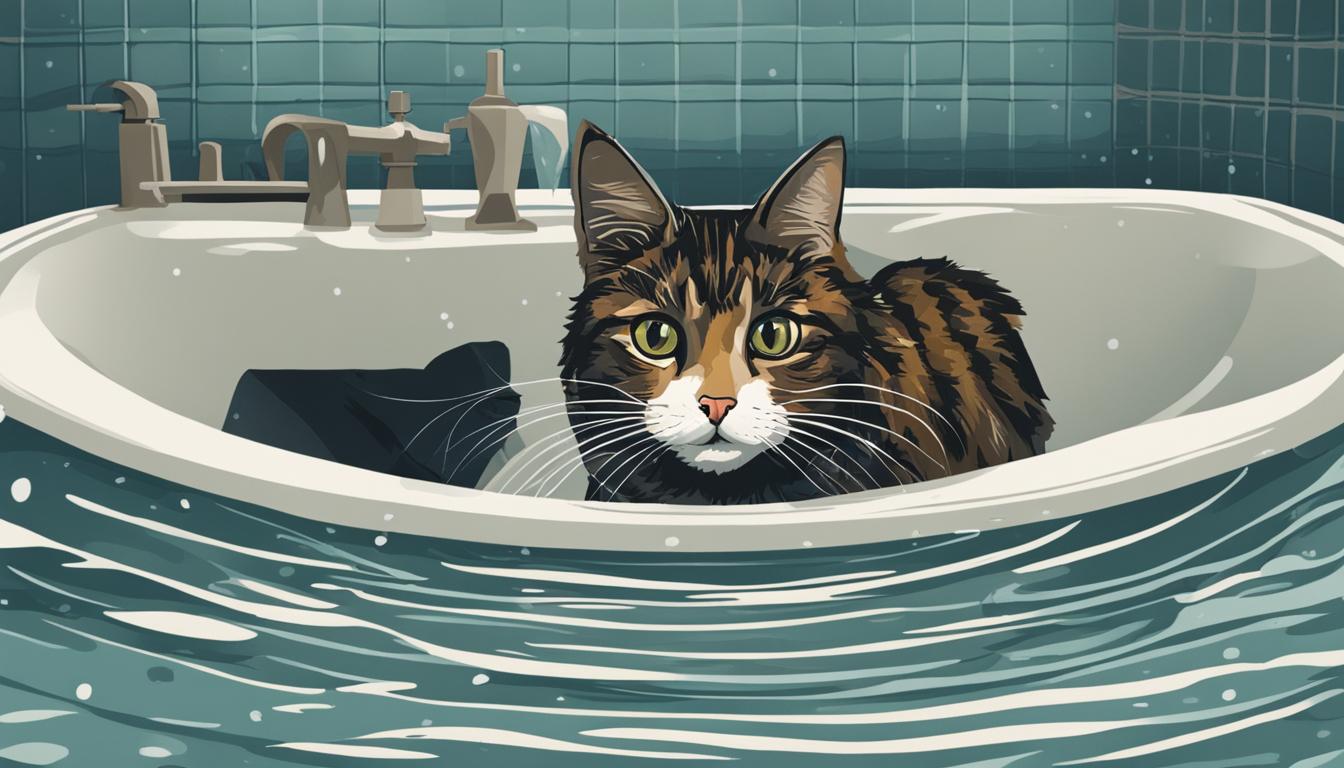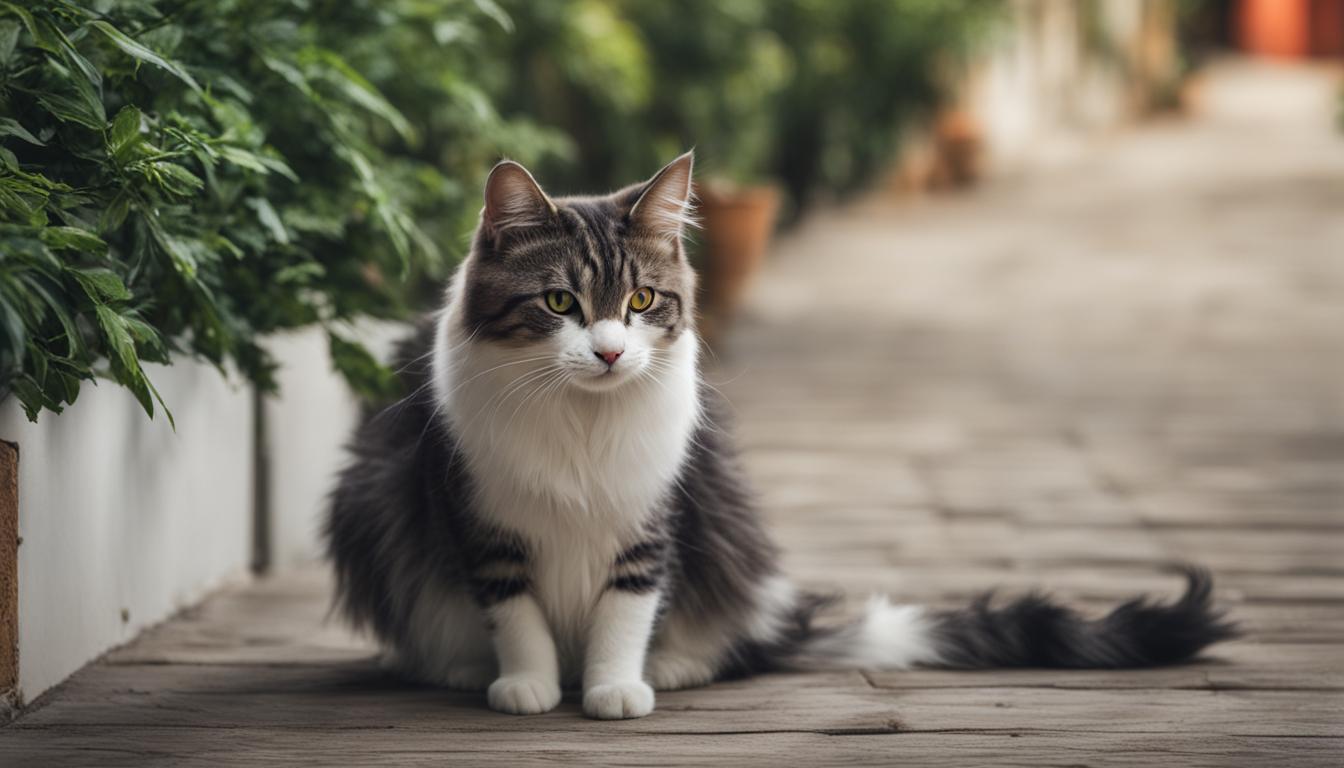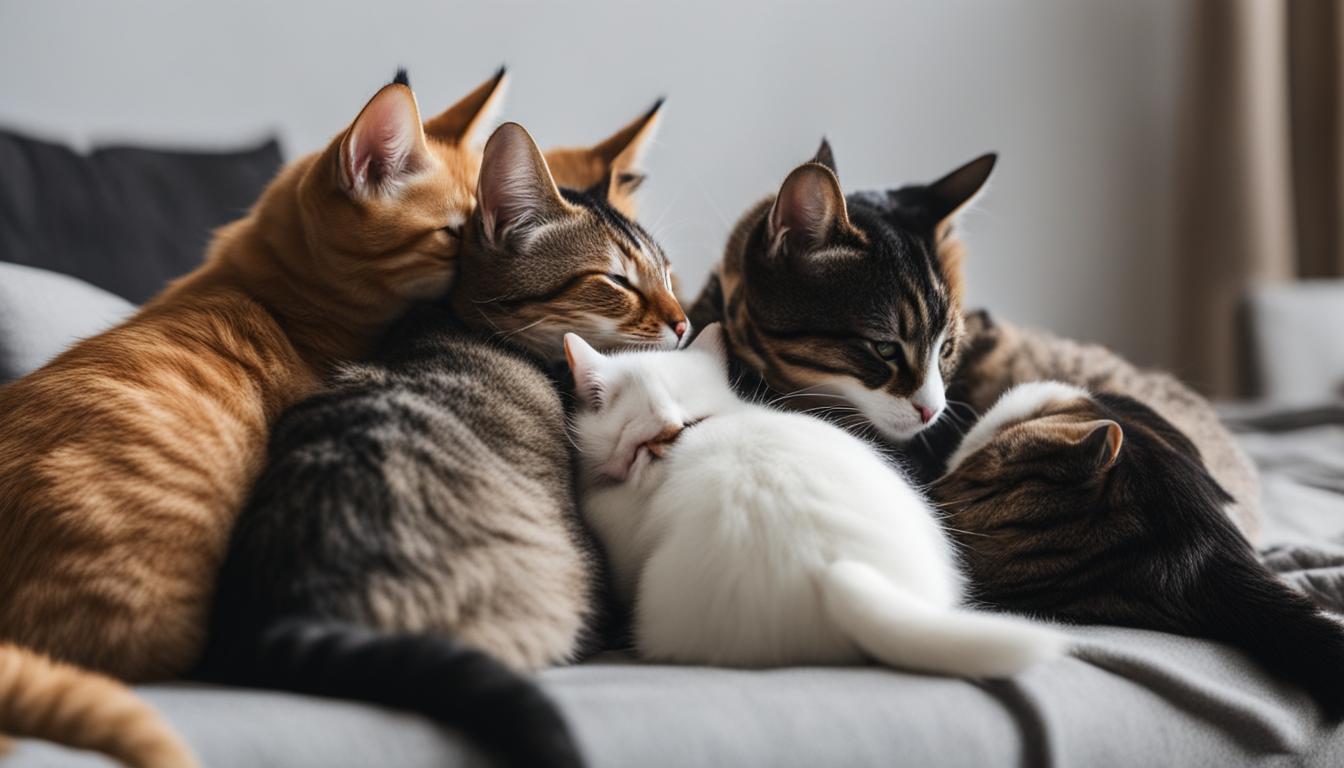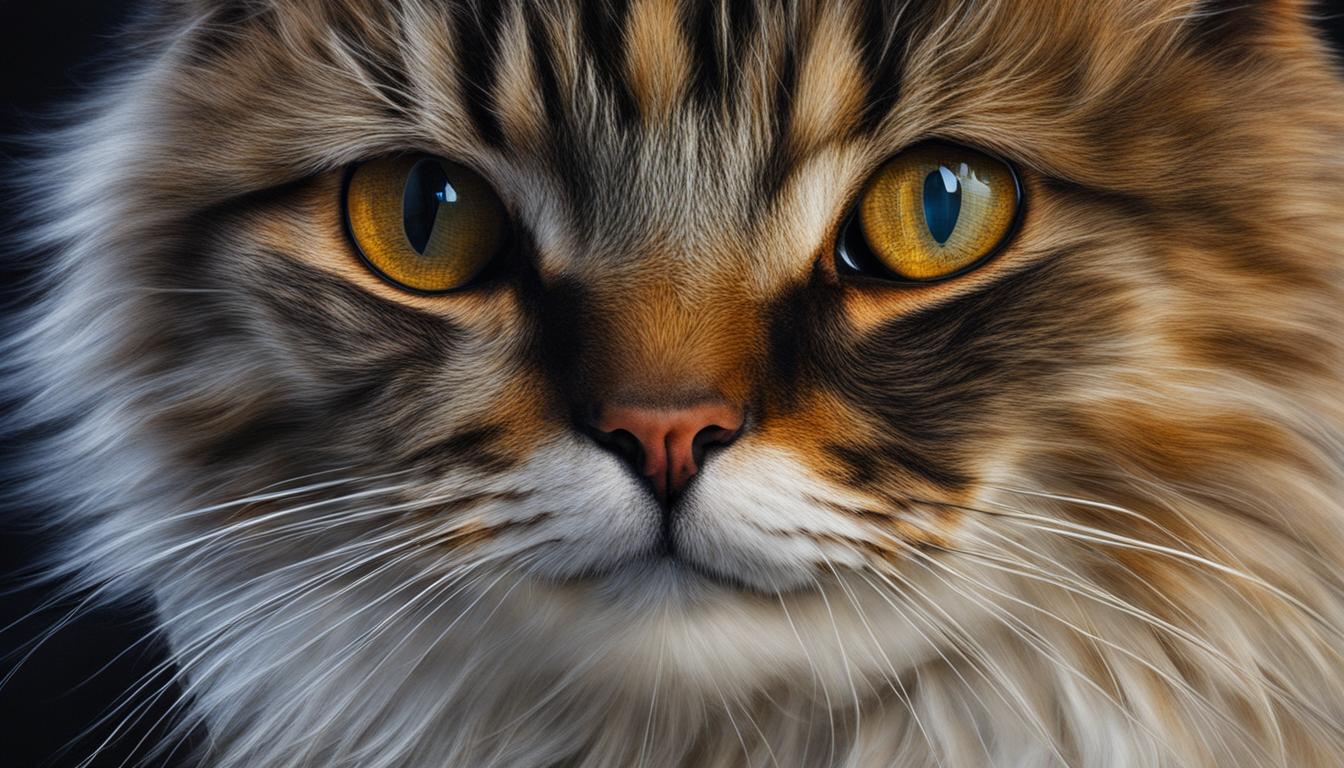Hey there, fellow feline enthusiasts! Today, we’re diving into the fascinating world of cats and their relationship with water. You know, that mysterious element that seems to either intrigue or terrify our whiskered companions. So, let’s put on our investigative hats and uncover the truth behind cats’ love or fear of water.
Cats have always been known for their independence and enigmatic behavior. When it comes to water, it’s no different. As desert animals, cats didn’t have to rely on water as heavily as other species. Their main source of hydration came from the prey they hunted. But as domesticated pets, they still need access to fresh water to stay healthy and hydrated.
Now, let’s dig into the details. Cats have their own preferences when it comes to drinking water. They like it separate from their food and litter, and preferably in shallow sources. They’re also attracted to the movement and sound of running water. It’s like their own kitty spa retreat!
But what about those notorious water aversions? Well, it turns out that not all cats are aquaphobic. Some breeds, like the Turkish Angora, Turkish Van, Maine Coon, and Norwegian Forest Cat, actually enjoy swimming and frolicking in water. It seems their ancestors’ water-rich environments left a lasting impression on their DNA.
Key Takeaways:
- Cats, being desert animals, didn’t require much water originally, but domesticated cats still need access to fresh water.
- Cats have preferences for drinking water, such as having it away from their food and litter.
- Some breeds of cats, like the Turkish Angora and Maine Coon, feel comfortable in water and can swim without fear.
- Cats are attracted to the movement and sound of running water.
- Not all cats have an aversion to water; some breeds actually enjoy swimming!
Cats’ Fascination with Running Water and Swimming Behavior
When it comes to water, many cats exhibit a fascination with its movement and sound. It’s not uncommon to find them playing, drinking, and even bathing in running water. This behavior can be traced back to their natural water instincts and ancestral origins in water-rich environments. Some cat breeds, such as Turkish Angora, Turkish Van, Maine Coon, and Norwegian Forest Cat, are even comfortable swimming.
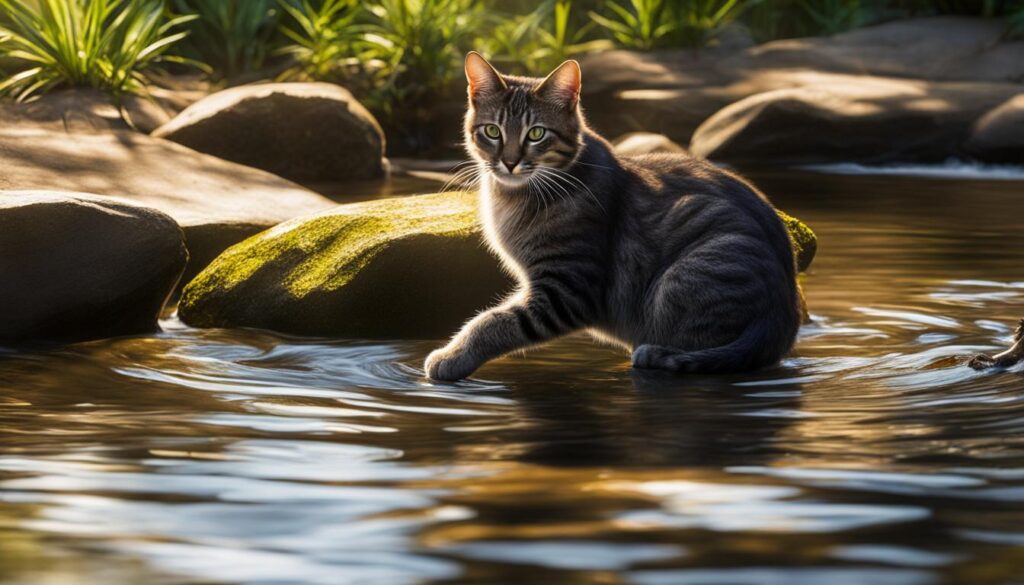
Cats’ affinity for water stems from their evolutionary adaptation for hunting in watercourses. Just like their big cat relatives, domestic cats have retained certain instincts related to water, despite not needing it as a primary source of hydration. The allure of running water, with its enticing movement and sound, is hard for many cats to resist.
To further understand this behavior, it’s important to recognize that cats are curious creatures by nature. The sight and sound of water can captivate their attention and trigger their hunting instincts. Whether it’s the anticipation of catching a drink or the desire to explore the watery environment, cats’ fascination with water is a testament to their innate curiosity and adaptability.
Cats’ Attachment to Their Owners
It’s a common misconception that cats are aloof and independent creatures who have no attachment to their owners. However, recent research has revealed that cats form strong emotional bonds with their human companions, similar to the attachment behavior seen in children. A study conducted by Oregon State University found that young cats between three and eight months of age displayed signs of separation anxiety when separated from their owners. This indicates a secure attachment and suggests that cats do have feelings for their owners.
When separated from their owners, the kittens in the study became visibly distressed, vocalizing more and exhibiting behaviors like pacing and excessive grooming. However, they were able to quickly calm down and relax upon their owner’s return. This behavior mirrors the behavior of children who display secure attachment, as they seek comfort from their caregivers when distressed and feel secure in their presence. It’s fascinating to see parallels between human and feline attachment behaviors.
“Cats are often misunderstood, but our study shows that they have a similar level of attachment to their human caregivers as dogs and young children. This bond is reinforced through interactions such as petting, talking, and spending quality time together.”
So, what can we take away from this research? It’s clear that cats have an emotional connection to their owners, seeking their presence and finding comfort in their company. As cat owners, it’s important to reciprocate this attachment by providing a loving and nurturing environment for our feline friends. Taking the time to engage in activities like petting, playing, and talking to our cats can strengthen the bond and ensure their well-being. Remember, cats may be independent, but they also crave love and companionship.
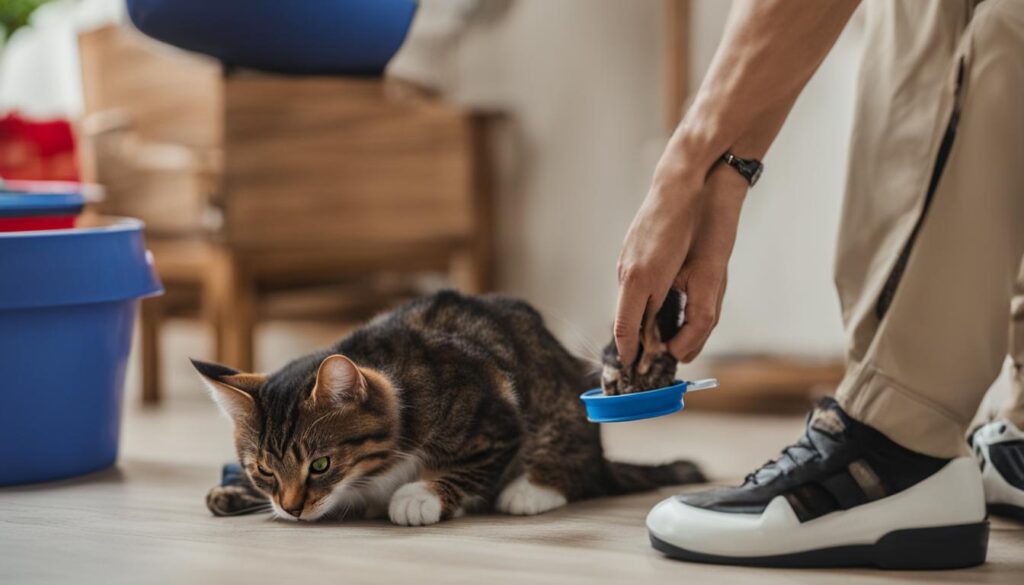
Table: Signs of Cats’ Attachment to Their Owners
| Signs of Attachment | Description |
|---|---|
| Vocalization | Cats may meow more frequently when separated from their owners, seeking their attention and presence. |
| Following Behavior | Cats may follow their owners around the house, wanting to be close to them and maintaining a physical connection. |
| Seeking Comfort | When distressed or anxious, cats may seek comfort from their owners, seeking physical contact or curling up next to them. |
| Calmness upon Reunion | Cats display a sense of relief and relaxation when their owners return after a separation, indicating a secure attachment. |
Cats’ Perception of Humans Compared to Other Cats
When it comes to cats’ social behavior, they don’t seem to perceive humans as fundamentally different from themselves. In fact, cats display similar social behaviors with humans as they do with other cats. They have a natural inclination to rub against their humans’ legs, sit beside them, and even groom them. This behavior indicates that cats view humans as part of their social circle, rather than as a separate species.
Unlike dogs, cats do not exhibit behaviors of dominance or submission towards humans. They do not view humans as inferior or superior, but rather as companions. However, cats do recognize that humans are bigger and can sometimes be clumsy, leading to occasional accidents like tripping over cats. Nevertheless, cats do not hold any grudges and continue to interact with their humans in a friendly manner.
Cats’ perception of humans can be attributed to their highly adaptable nature. They are able to form strong bonds with their human companions, showing affection and seeking comfort from them. This is supported by research that demonstrates cats’ attachment behavior towards their owners, similar to that seen in young children. Cats become visibly distressed when separated from their owners, further indicating their emotional connection.
Cats’ Social Behaviors with Humans:
- Rubbing against legs: Cats use scent glands located on their faces and bodies to mark their territory and show affection. Rubbing against their humans’ legs is a way for cats to claim ownership and strengthen their bond.
- Sitting beside humans: Cats often choose to sit close to their humans, especially when they feel safe and comfortable in their presence. This proximity serves as a form of companionship and reassurance.
- Grooming humans: Cats may groom their humans as a sign of affection. Grooming is a behavior commonly observed between cats, used to strengthen social bonds, and when cats groom their humans, it signifies their acceptance and trust.
Overall, cats’ social behavior with humans reflects their ability to form emotional connections and view humans as part of their social circle. Understanding and respecting cats’ social behaviors is important for nurturing a strong bond between cats and their human companions.
| Cats’ Perception of Humans | Cats’ Social Behavior with Humans |
|---|---|
| Cats view humans as part of their social circle. | Cats rub against legs, sit beside, and groom humans. |
| Cats do not exhibit behaviors of dominance or submission towards humans. | Cats seek companionship and comfort from their humans. |
| Cats recognize that humans are bigger and can be clumsy. | Cats form strong emotional bonds with their human companions. |

Cats’ Mental Well-Being and Stress Factors
When it comes to our furry feline friends, it’s essential to consider not only their physical health but also their mental well-being. Cats are known for their independent and resilient nature, but they can also experience stress, which can have a negative impact on their overall quality of life.
There are several common stress factors that can affect cats. One major source of stress for cats is conflict with other cats in the household. Cats are territorial animals, and clashes over territory can lead to physical fights and tension among feline companions. This can result in various health issues such as dermatitis and cystitis, which can be exacerbated by psychological stress.
To ensure a peaceful and harmonious environment for your cats, it’s important to address their social lifestyles. Providing multiple resources such as food bowls, litter boxes, and resting areas can minimize competition and reduce stress. Additionally, creating vertical spaces such as cat trees and shelves can give cats opportunities to retreat and establish their territories.
Understanding the stress factors that affect cats is crucial for their mental well-being. By recognizing the signs of stress, such as changes in appetite, grooming habits, or litter box usage, and implementing strategies to alleviate stress, cat owners can help their furry companions lead happier and healthier lives.
Signs of Stress in Cats:
- Decreased appetite
- Excessive grooming or lack of grooming
- Inappropriate scratching or marking
- Changes in litter box habits
- Withdrawal or hiding
- Aggression or excessive vocalization
Reducing Stress in Cats:
- Create a peaceful environment with adequate resources
- Implement a regular play and exercise routine
- Provide hiding spots and vertical spaces
- Use pheromone diffusers or calming sprays
- Introduce new stimuli gradually
- Consult with a veterinarian or animal behaviorist for further assistance
By prioritizing the mental well-being of our beloved cats, we can help create a stress-free and fulfilling life for them.
| Common Stress Factors in Cats | Signs of Stress |
|---|---|
| Conflict with other cats | Decreased appetite |
| Changes in the household | Excessive grooming or lack of grooming |
| Unfamiliar environments or people | Inappropriate scratching or marking |
| Lack of stimulation | Changes in litter box habits |
| Medical issues | Withdrawal or hiding |
Training Cats to Tolerate Water and Bathing Techniques
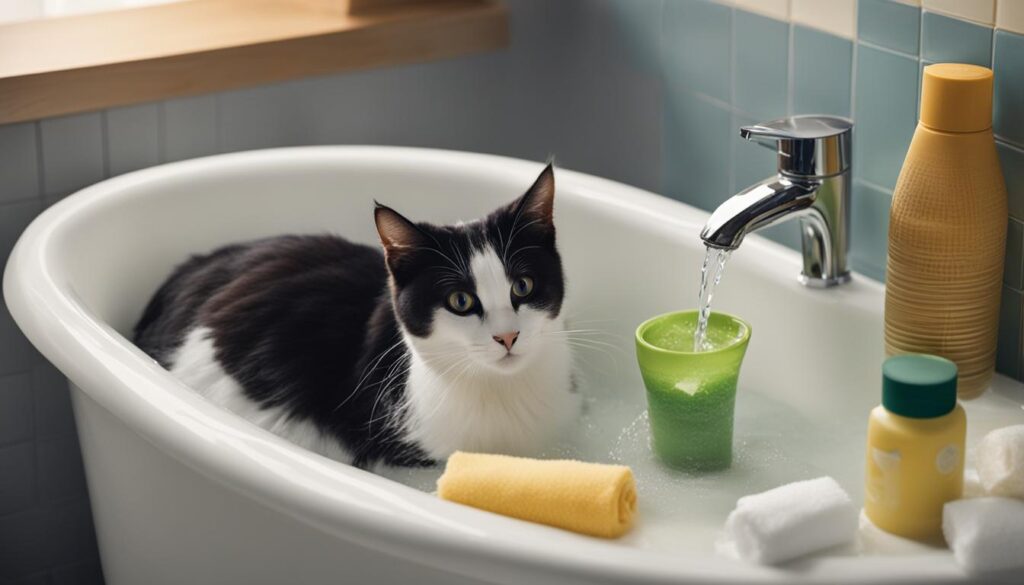
While many cats have an innate aversion to water, it is possible to train them to tolerate it and even enjoy it to some extent. Whether you need to give your feline friend a bath or simply want to help them overcome their fear of water, here are some tips and techniques to make the process smoother and more comfortable.
Gradual Exposure and Positive Reinforcement
One of the most effective ways to train a cat to tolerate water is through gradual exposure combined with positive reinforcement. Start by introducing your cat to water in a controlled and calm environment. Fill a basin or sink with a small amount of lukewarm water and allow your cat to explore it at their own pace. Use treats, praises, and gentle strokes to reward their calm behavior and create positive associations with water.
Bathing Techniques
When it comes to bathing your cat, it’s essential to use gentle techniques that respect their natural instincts and preferences. Use a pet-friendly shampoo that is specifically designed for cats, as human shampoos can be too harsh for their sensitive skin. Ensure the water temperature is warm and comfortable, and always avoid getting water in their eyes, ears, and nose. A handheld sprayer or a pitcher can help control the water flow and minimize the stress for your cat. Remember to talk to your cat in a soothing voice throughout the process to provide reassurance and support.
Respecting Individual Preferences
It’s important to note that not all cats will readily accept water, and forcing them into situations that cause distress can be counterproductive. Respect your cat’s individual preferences and comfort level when it comes to water. If your cat absolutely refuses to tolerate water, you can try alternative methods of keeping them clean, such as using dry shampoos or grooming wipes. Always prioritize your cat’s well-being and ensure their safety and comfort during any water-related activities.
Training cats to tolerate water requires patience, understanding, and respect for their individual needs. By following these techniques and adapting them to your cat’s personality, you can help them overcome their aversion and develop a more positive relationship with water.
Conclusion: Cats’ Relationship with Water
Throughout history, cats have had a fascinating and complex relationship with water. From their origins in desert environments to their evolutionary adaptations, cats’ views on water vary greatly from one individual to another. While some cats are naturally drawn to water and may even enjoy swimming, others may harbor fears and aversions. It is important for cat owners to understand and respect these preferences in order to promote their feline companions’ well-being.
Helping cats overcome their water fears can be a gradual process that requires patience and understanding. By creating a stress-free environment, providing access to fresh water sources, and considering individual bathing preferences, cat owners can help their furry friends feel more comfortable around water. Positive reinforcement techniques, such as offering treats and praise, can also be effective in building confidence.
For cats with severe water aversions, water therapy can be a helpful option. This specialized treatment involves gradually introducing cats to water in a controlled and calm environment. Under the guidance of a professional, cats can learn to associate water with positive experiences, gradually reducing their fears and anxieties.
As we continue to learn more about cats and their fascinating relationship with water, it is important to approach their needs and preferences with empathy and respect. By understanding their historical perspectives and providing the necessary support, we can help cats have a healthier and happier relationship with water.
FAQ
Do all cats hate water?
No, not all cats hate water. Some cats are fascinated by it, and certain breeds even enjoy swimming.
Can I train my cat to like water?
While it is possible to train cats to tolerate water, it is important to respect their individual preferences and not force them into situations that cause distress.
How can I bathe my cat without causing stress?
When bathing a cat, it is important to use warm water, wash them gently, and avoid getting water on their head. Using a soothing voice can help reassure the cat during the process.
What can I do to improve my cat’s mental well-being?
Providing a peaceful and harmonious environment, addressing social conflicts, and understanding stress factors can significantly improve a cat’s mental well-being.
Do cats form attachments to their owners?
Yes, cats can form close bonds with their owners and display attachment behavior similar to that of children.
How do cats perceive humans compared to other cats?
Cats do not view humans as fundamentally different from themselves. They display similar social behaviors with humans as they do with other cats.
Are there certain breeds of cats that enjoy water more than others?
Yes, breeds such as the Turkish Angora, Turkish Van, Maine Coon, and Norwegian Forest Cat feel comfortable in water and can swim without fear.
Why do cats prefer shallow water sources?
Cats prefer drinking from shallow water sources as it mimics their natural instincts and reduces the risk of getting their whiskers wet.
Can cats recognize their owners?
Cats do recognize their owners and feel safe and secure in their presence.
How can I help my cat overcome their fear of water?
Gradual exposure, positive reinforcement, and creating a stress-free environment can help cats overcome their fear of water.

